|
Highlights (Parts of this section) |
|
|
›This section of the I.N.G.N. will be entirely devoted to the persuit of models of small railroads, prototypical or freelance. If our dear readers would like to add something to this page, please feel free to write! Of course On18 is our specialty here, but being true 'rubber gaugers' we have many ideas and setups and would like to display yours here too.
›
›
There are many scales and gauges out there. Being affiliated with about 50 (most model railroad oriented) email-groups I have seen a lot. Two foot gauge along with the 'minimum gauges' seem to be my favorite. Gn15 (1/24th scale on HO scale track) and 3/8n20 (1/32nd scale on HO scale track) are two of my favorite larger ones. Frank Savery, the 'Fat Controller' of the Modelling Minimum Gauge group on Yahoo recently showed some examples of usage of inexpensive Lemax figures for 1/32nd scale. Figures are one of the hardest things to come by in odd scales, so his photos really are inspiring to change scales! Let's see 3/8n18 = 9/16" (=.5625" = 14.3mm), hmm, is that a recognized gauge? TT maybe?!? 3/8n2=3/4" = On3 track and if you use 1/29th (about 10% larger), O scale track = 3 foot gauge!
I have been delving into 1/20th (F scale) a little bit and been cutting beams for the underframe of a 1/20th model of the Sumpter Valley Caboose for my garden railroad 'train set' (all portable - 'N.U.T.S.' - Not Usually To Scale!). Calling it my 'train set' is the only way I can justify running 1/20th and 1/24th Bachmann equipment and 1/22.5 LGB equipment together! So how about Fn2 - 1/20th scale running on O scale standard gauge track? All these are nice sizes, but they really don't fill all my model railroading desires. A prime example of 'almost' is F-scale: I really like the size of it, but it is really too big for indoors but too small for reliable operation outdoors AND though it ends up costing about the same as live steam for quality scale models, you can't ride it!
So, what to do? Invent a new scale/gauge! My latest speculative scale/gauge? 1/10th n2 and n3. At 1.2" scale (actually a metric scale of 1:10 for the rest of the world) these end up being compatible with the smallest live steam gauges of 2 1/2" and 3 1/2". Unlike the rest of the live steam gauges, these are the same worldwide! Interestingly 1/10th n18 is just about right for G-scale 45mm track. I really think this will be a good scale with many advantages:
Some drawbacks:
If this will turn into an actual working project or just an 'armchair idea' is another thing.... Though I have a small machine shop and have some 1/2"x2 1/2" brass bar that could be made into a couple dozen wheels in a weekend, I have not gone beyond the sketching plans stage.
One of my plans is for a 1/10n2 SR&RL #556 caboose to be used for a mailbox. I would like to mount it on a track that when activated by a button on the front porch (about 150 feet away) the 'mailbox-caboose' rolls across the lawn and up onto the porch for mail retrieval! I will post some of my sketches and ideas later, maybe some photos too....
›
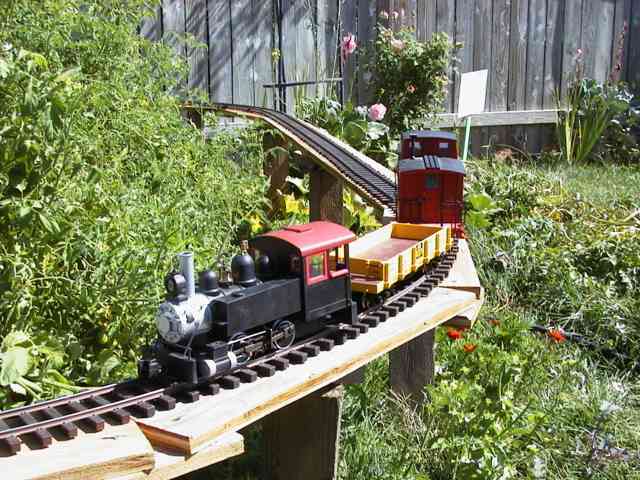
This past weekend (September 14, 2002) the meeting of the infamous Southern Idaho G-Scalers went on in Boise and I was unable to attend, so I had my own Garden Railroad Show at the in-law's house in West Boise. I have been planning to install my portable track that served as the lower level of our Thomas the Tank Engine display train (in Emmett in June) in my wife's garden and I finally got it done.
Since I already had the roadbed cut out and the track ready to lay, all I had to do was cut some stakes to support it and install it. A garden railroad in two hours! So here's the show; no one actually attended besides myself, our little girl and our two puzzled cats so here is the virtual show for all to see....
The title photo above shows the southwest corner of the layout with the potatoes to the right, some 'flowers' below and the roses in the background. Sorry I am not great at describing the flora like Garden Railways Magazine, maybe you can tell ME the exact genus and species of these!
›
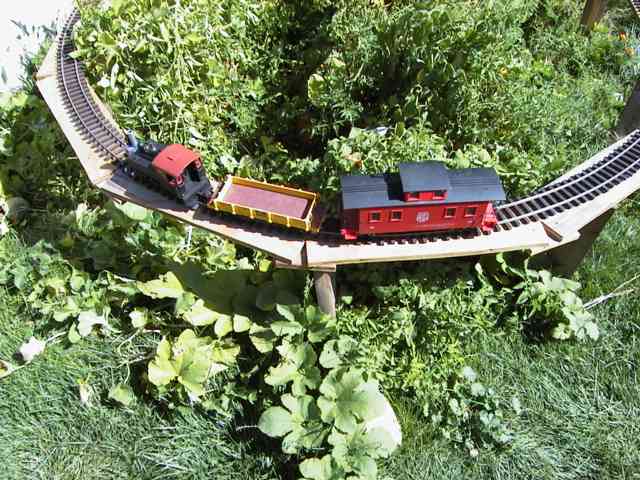
As we proceed around the layout an overhead view shows a little of the detail of the simple track bed: 3/4" plywood 6" wide with 6"x6" plywoood cleats screwed between joints. The track is Micro Engineering code 250 weathered aluminum rail on ME tie strips. The rail sections are 6 feet long so that is the length of the straights. The curves are about 45" radius which made the six foot rails exactly 90 degrees and only the inside rail had to be cut a couple inches to join up. The roadbed in the curves ended up being 24" long and 30 degrees each. It is all screwed to the tops of 2x4 stakes about three feet apart and lined up by eye.
›
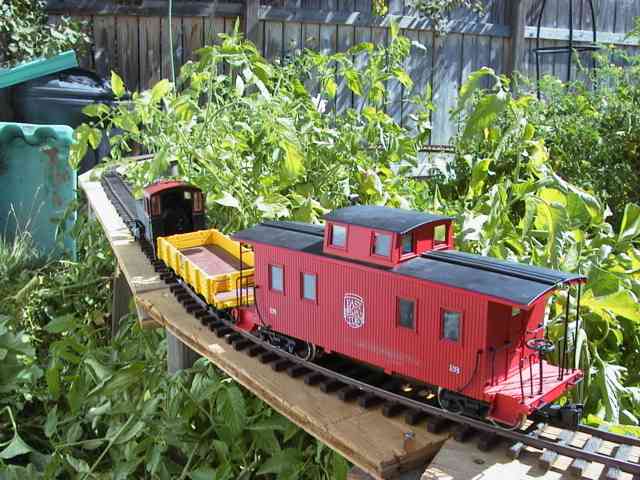
The backside of the layout along the shed and through the forest of tomatoes. The Bachmann EBT caboose looks too large for the Porter and it is. The flat is one of Bachmann's 20' 1/24th scale ones so looks more fitting.
›
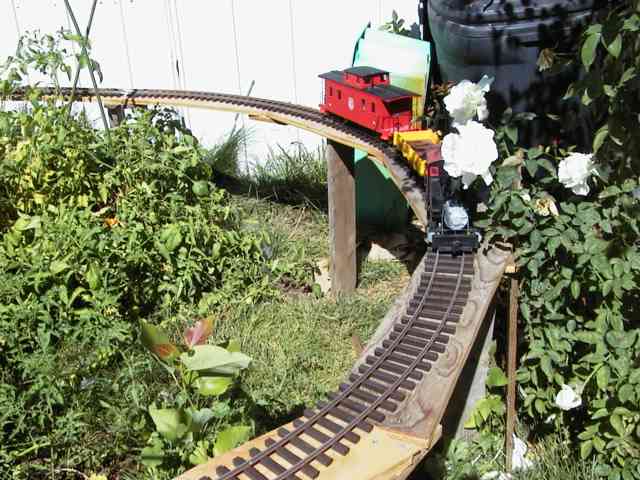
›The far curve by the roses is next. The white roses here look like an unplanned plume of steam and smoke. The stick on the right is not part of the track support but is solely to hold the rosebush off the track. A few poplars are sprouting in the garden (one near the bottom of the rose stake, another inside the curve) and will be transplanted out soon.
›
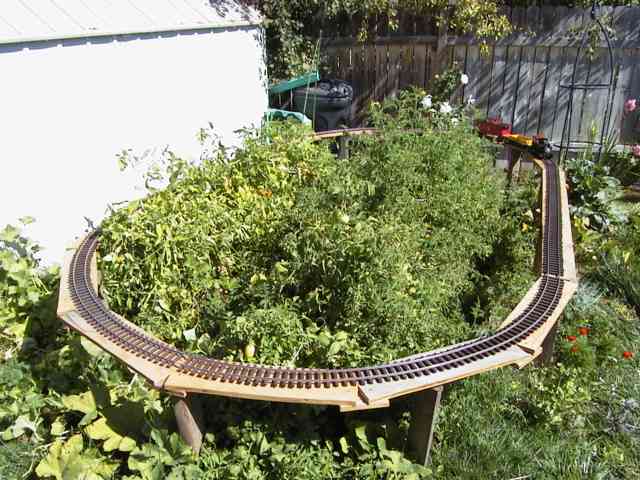
An overview of the layout and the train passing the poor tweeked garden obelisk (a fine product of LTD Commodities).
As a temporary layout it will be gone with the garden in a matter of weeks so the track is not attached to the roadbed (actually the power is just connected with aligator clips so for the photos the train was pushed!) The track is not the truest, but everything seems to work.
Well, that's the tour. I hope to bring the rest of my cars to Boise (I have a dozen assorted Sumpter Valley freight cars) and take some more photos soon.
Contact: unknown1@myrealbox.com
posted 30.09.2002